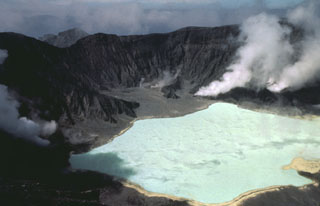Report on El Chichon (Mexico) — February 1984
Scientific Event Alert Network Bulletin, vol. 9, no. 2 (February 1984)
Managing Editor: Lindsay McClelland.
El Chichon (Mexico) No new eruptions; crater lake conditions unchanged
Please cite this report as:
Global Volcanism Program, 1984. Report on El Chichon (Mexico) (McClelland, L., ed.). Scientific Event Alert Network Bulletin, 9:2. Smithsonian Institution. https://doi.org/10.5479/si.GVP.SEAN198402-341120
El Chichon
Mexico
17.3602°N, 93.2297°W; summit elev. 1150 m
All times are local (unless otherwise noted)
A team of scientists from UNAM and elsewhere visited El Chichón's crater lake on 15 February. There was no evidence of recent eruptive activity. Temperature (43°C) and pH (1.9) of the lake had changed little since the previous visit on 21 October 1983 (42°C and 1.8). High concentrations of H2S forced the geologists to leave after 40 minutes. Photographs taken in December 1983 showed little change in lake level since October; no information on lake level was available from the February visit.
Geological Summary. El Chichón is a small trachyandesitic tuff cone and lava dome complex in an isolated part of the Chiapas region in SE México. Prior to 1982, this relatively unknown volcano was heavily forested and of no greater height than adjacent non-volcanic peaks. The largest dome, the former summit of the volcano, was constructed within a 1.6 x 2 km summit crater created about 220,000 years ago. Two other large craters are located on the SW and SE flanks; a lava dome fills the SW crater, and an older dome is located on the NW flank. More than ten large explosive eruptions have occurred since the mid-Holocene. The powerful 1982 explosive eruptions of high-sulfur, anhydrite-bearing magma destroyed the summit lava dome and were accompanied by pyroclastic flows and surges that devastated an area extending about 8 km around the volcano. The eruptions created a new 1-km-wide, 300-m-deep crater that now contains an acidic crater lake.
Information Contacts: S. de la Cruz-Reyna, UNAM; T. Casadevall, USGS.

